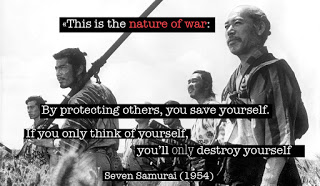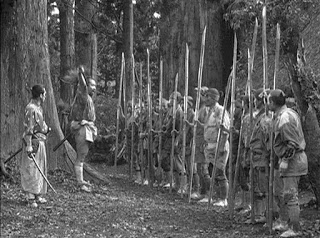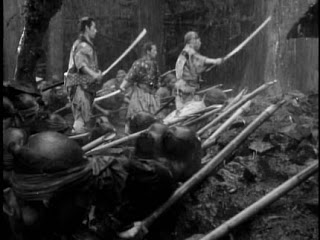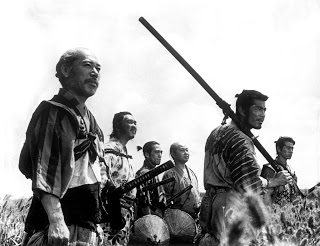I have had overwhelming requests for Praxis posts to teach
current Army doctrine adapted for everyone else. To date, the most popular post I have done
was the original Defense post relating to some of my experiences during the
Surge in 2007-2008. I see the utility in
expanding this subject into a series of posts to delve further into the subject
of defensive operations. In time, I will
expand these Praxis posts to tackle the subjects of Offense, Sustainability,
the basics of Maneuver warfare, and other aspects of 4th Generation warfare
that have not been covered in the many excellent Praxis posts in the Sipsey
Street archives.
Hundreds of hours poring through information on the internet
will not replicate actual training. The information I will push out will be from
current and historical examples but not everything will translate to your
situation. I will mainly be speaking to
an audience interested in neighborhood or town defense. Smaller footprints like a farm or duplex will
have its own challenges that stem mainly from the lack of available manpower. Anything larger than population centers above
10,000 will have unique challenges that are bigger picture, but the fundamentals
of defense remain. It is incumbent upon
you to take the information, throw out what you do not need, adapt it to what
you know, and then test it out. Testing
as much as practical before you will need it is the resounding advantage that
you have over everyone else. I wish you
nothing but success in your journey to building a better citizen.
Defense
The strength of offense lies in the ability to choose the time
and the place from which to attack.
Defense is generally stronger because the defenders can choose the
ground, improve upon it, and then direct internal resources where it is
needed. The defender will be in position
prior to the event, so they will have the “home court advantage” to mold the
battle space into what will play into their strengths. Even if it is only moments before the attack,
a defender can use the natural or manmade structures to channel and disrupt the
momentum of the attacker. Defense gives
you the ability to not only hold the ground, but to wait until there are less
attackers, (due to attrition), or more information has been
presented.
Of course, offense is more decisive because only through the
attack can you secure a victory. Victory in your situation may be simply defending a homestead,
but eventually you will have to go on the attack if you want to completely
eliminate an enemy force. Examples in
American history since the 1950’s where western niceties prevented the military
from directly engaging with an enemy on
their home turf are abundant. Korea at the
38th Parallel, Vietnam with Laos and Cambodia, and the Global War on
Terror with Syria and Iran all readily spring to mind. The opponent was then able to continuously
regroup, rearm, and reengage. We lost
the will to fight only when we artificially tied both arms behind our
backs. Offense can bring you victory, but
you must first be able to keep what you have.
Every task, after all, does not require a hammer.
There are several reasons to go on the defense. Traditionally it is, of course, used to stop
an attack but it can also be used as a delaying tactic until a better
opportunity presents itself. Defense can
be for a specific purpose such as the protection of a population, key terrain,
important buildings and infrastructure. Defense is also a form of information
gathering. The type of enemy, what
weapons they use, distinctive uniforms, and tactics can also be gleaned from a
defensive posture. In the defense, you
will have the base of operations to employ reconnaissance elements to feed you information*.
There are two characteristics of defense, disruption and flexibility
, that you will want to be familiar with.
With disruption, keep in mind that the success of an attack rests
largely on its momentum: the swift and decisive movement to violence that overwhelms
the defendors either through superior numbers or firepower. The defender can disrupt that momentum, slow
it to a crawl and even prevent the attack from proceeding. You can accomplish this by breaking up their formations,
disrupting their intelligence gathering and reconnaissance capabilities,
isolating units through channeling the attackers to places they would not want
to go, or disrupting their communication and supply nodes.
Flexibility of defense may seem counterintuitive if you
think of defense in terms of a Maginot Line of rigid walls and bunkers, but in
reality commanders must have the ability to maneuver their resources around the
battle space to maximize the defenders advantage to match the attackers
strength. An excellent example of optimizing
your manpower and resources can be found in We Were Soldiers Once, And Young
and is illustrated fairly well in the movie adaptation. Another successful defense is that of Rorke’s Drift by 150 British Soldiers against
4,000 Zulu warriors is an excellent example of using terrain and resources, (and
just a few hours of warning), to defeat overwhelming hoards of determined
attackers.
In a town or larger population center, you will have the
ability to form rings of defenses around your area. This is presuming that the area you have to
defend is not so large as to make it impractical to hold. Being unable to judge the battle space and know
your limitations is the critical flaw in defensive planning.
So you must be saying at this point, “okay, great, now what do I do”? As defined by the Army, there are three types of battle positions in defense.
So you must be saying at this point, “okay, great, now what do I do”? As defined by the Army, there are three types of battle positions in defense.
Primary positions – These are your main positions of defense. They will have the bulk of your forces and allocation of resources. The primary positions are set along the likely avenues of approach for attackers. This will be bridges and overpasses, cross roads and road junctions, or other avenues of approach. When planning, keep in mind that avenues of approach can be 360 degrees around your location. You will need to look at local airports, rail junctions, forested areas, waterways, or anything that could be a blind spot or attractive avenue of attack.
Alternative Positions
- These are the positions that you will station a reserve unit or assisting
weapons platform to assist the primary position. You will have a designated marksman, suppressive
fire weapon, or squad of defenders that can augment the primary positions if
they are in danger of getting overrun.
Strong Point –
The Strong Point is your redoubt and the last stand before you abandon the
defense. It is heavily fortified and
should be provisioned in the event that the unit becomes surrounded and
isolated. The presumption of the strong
point is that you will be able to call in reinforcements and this position is
to insulate you until the cavalry arrives.
This, of course, is not the case with every unit. I would strongly advise that you plan in
multiple avenues of escape. I beg the
pardon to my proud Texan readers, but dying in an Alamo-esque battle, while
romantic, will not advance your cause.
Depending on how much time you have to set up a defensive position, you can employ certain tricks to direct your assets to where it is needed and when it is needed. You can use range cards to determine where you need to put your weapon sights at known distances. For the uninitiated, the range card is a drawing of certain obvious terrain features and their distances.
The advantage of the defender lies in the ability to set up
these devices ahead of time to disrupt, dissuade or prevent the attack. The Defender can employ various early warning
systems or pyrotechnics in an either offensive or defensive manner. Trip wire, flash grenades, smoke, punji
sticks, dead falls, rock traps, and man catchers; there is no end to devious
inventions that humans have developed over the millennia of killing each other to
help improve their defenses. With
passive security devices, you will need to be cognizant that a mine or trap
does not care if it is your child or your enemy that trips it. You will need to be completely aware of this
fact and guard against the device being used improperly.
Quick Reaction Forces, (QRF), is another tool the defender
can use to move fighting forces quickly to where it is needed when you are in a
fixed defensive position. The QRF is a squad or platoon size element that is on
call 24 hours a day with the express purpose of getting to a location quickly
to assist the defenders. In taking the
long and macro view, this was essentially what the original Minute Men
were. The Army will segregate their QRF
force in a designated area and will leave them alone for everything but the
most mundane chores. Once the call comes
up, they are to drop everything and come to where they are needed. The QRF is the best example of how a
commander can use the flexibility of defense to their advantage. The weak point in this is the availability to
disseminate accurate, clear, and timely information as to where they need to be
sent. Much has been written on battle
field communications here and elsewhere, that I would strongly advise you to
seek out.
At some point you may have to abandon your defense and
retreat to another location. This is
especially important for skirmishers that are in improvised defenses that are
not suitable to defend against the brunt of a concentrated attack. Prior to the attack, you will want to
establish a "disengagement line". This
line is an arbitrary distance that you determine that says that if the opposing
force is able to advance to a certain point, it will be impractical to defend
and so everyone will know that they will need to abandon the position and
retreat to a better defensible location.
Many different mathematical equations exist to give you an idea
of how many attackers are needed to overwhelm the defenders. While helpful to bean counters and armchair war
gamers, it is not very useful to defensive planning. Your opponent will throw everything that they
can at you until they give up the attack, are destroyed, or move on to an
easier target. Proper planning does
prevent piss poor performance. The
advantage of the defender is in the ability to consider a piece of land or a
populated area and determine what they can do to improve their chances of
living and success of the mission.
*Mikes note: Most of your success in the defense relies on your ability to employ reconnaissance of all types. This includes electronic but especially patrolling, and it will give you a clear picture of what is going on in your neighborhood and the surrounding terrain. Also, the best way to disrupt an attack is to know that it will happen. You can initiate a counter attack when the enemy is must vulnerable and does not expect it. In essence, when he comes out of his hole to attack your hole. The small teams of SOG in Vietnam keenly understood this. When the VC crawled out of their tunnels and consolidated their force, the SOG was able to identify those muster areas and brought in air support to destroy the attack before it was able to materialize. In it's way, intelligence is the most critical element of defense.
It harkens back to Sun Tzu; “If you know the enemy and know yourself, you need not fear the result of a hundred battles. If you know yourself but not the enemy, for every victory gained you will also suffer a defeat. If you know neither the enemy nor yourself, you will succumb in every battle.”
An old Platoon Leader of mine drilled into my head to “improve
your foxhole a little every day”. Your
particular foxhole can be your house, your block, your subdivision, or your
town. Each place presents itself with unique
challenges and advantages to defend. One
huge advantage that is generally glossed over by historians is the advantage of
defenders when protecting their own homes and families. Forsaking your family and neighbors by
failing to plan and prepare for their defense is unthinkable. Simply by reading this series on defense, you
can no longer claim ignorance to the subject.
You now have responsibility to prepare what you can now, by having the
discussions with yourself, your family, and anyone that will allow you to bend their
ear.
*Mikes note: Most of your success in the defense relies on your ability to employ reconnaissance of all types. This includes electronic but especially patrolling, and it will give you a clear picture of what is going on in your neighborhood and the surrounding terrain. Also, the best way to disrupt an attack is to know that it will happen. You can initiate a counter attack when the enemy is must vulnerable and does not expect it. In essence, when he comes out of his hole to attack your hole. The small teams of SOG in Vietnam keenly understood this. When the VC crawled out of their tunnels and consolidated their force, the SOG was able to identify those muster areas and brought in air support to destroy the attack before it was able to materialize. In it's way, intelligence is the most critical element of defense.
It harkens back to Sun Tzu; “If you know the enemy and know yourself, you need not fear the result of a hundred battles. If you know yourself but not the enemy, for every victory gained you will also suffer a defeat. If you know neither the enemy nor yourself, you will succumb in every battle.”






10 comments:
Matt,
Good post. Edit: Several times in the discussion of range cards, you use the word "site" or "sites" when I think you mean the "sights" on your weapons.
Thank you for doing the job.
More on this can only be helpful. I have an NPP (Neighborhood Protection Plan) but unfortunately, no one in the neighborhood is receptive to the idea of even looking at it. Almost to a man, they don't see any approaching danger, and won't even consider my "ravings". They honestly believe that everything will be ok, and most of them, when asked, say they will load up the car/van/truck, and haul ass. What they don't like is when I tell them they'll be stuck on the highway with a couple million other clueless idiots who are now refugees, and they'll have no plan to speak of, except to die of thirst/riots/FSA/and other abuses awaiting those whose plan is only to run. About half believe govt. will ride to their rescue, only to give me a dirty look when I tell them govt. is only concerned with itself, and seizing whatever of value to itself that it can find. I may be left only with a remnant, and that will be people too slow/old/hesitant to leave. Should be fun. In the end, I will be relocating too, only planned in my case.
Anon: 9:42 - Thank you so much. I have made numerous corrections since.
Sean: I had a wonderful conversation yesterday with a gentleman that has a very great blueprint for a neighborhood watch system. He will test it out in the coming months and will be able to give a report here on what worked and what didn't. The "big idea" is to form squads of friends and neighbors with a common connection. In this case it will be a church, but it can be applied to any sports league, poker group, or about any other social organization. Bugging in will look more practical when you know your neighbors.
More to follow.
'Preppers' say Obama 'has divided us on a course for civil war'
Obama has pushed the "prepper movement" into high gear, sending millions to buy guns, survival gear and food to live through a "civil war," according to a nationally known survivalist who calls on Americans to prepare in a new book.
Bryce M. Towsley, whose "Prepper Guns" details the best weapons and ammo to survive a political or natural disaster, wrote, "I have watched in horror as Obama has attacked America with the brilliance that has allowed him to succeed."
The National Rifle Association field editor and a well-known survivalist said he is calling on Americans to be ready for a situation in which authorities can't be trusted
http://www.washingtonexaminer.com/preppers-say-obama-has-divided-us-on-a-course-for-civil-war/article/2591381
An important note on defense vs. offense, offense requires a much higher level of individual capability in the attacking forces, both physical and emotional. Men (and even women and children) who can (or will) do nothing but fire blindly in the general direction of the enemy can seriously impede an attacker, in sufficient numbers. They are of no use at all to an attack. Those able to place aimed fire on the enemy but lacking significant ability to maneuver can provide the bulk of the functions of defense, for offensive operations they are a supporting element of strictly limited utility (and a potential liability should plans gang awry). The raw physical ability to maintain a meaningful degree of forward progress while carrying arms and equipment eliminates all but a small fraction of the population from being able to participate in offensive operations, and even relatively minor injuries and simple fatigue can put an end to an individuals participation in offense while being only inconvenient to a defender.
This is most significant when the defenders are able to build deep support in the area being defended, but it remains true whatever the numbers.
A quick reaction force is essentially defensive despite requiring a level of combat ability suitable for offensive operations. It has been treated well enough that I feel only the need to mention that a reaction force should be moved through 'internal' lines of communication as much as possible. A counterattack, on the other hand, is an offensive operation, though hopefully carried out against an enemy that has significantly exhausted (or neglected) its self-defensive capability. For this reason a counterattack may be able to leverage supporting elements that would not be suitable for initial offense. Unlike a reaction force, a counterattack must move through areas held or at least contested by the enemy. This fundamental difference must be understood and such actions should be planned accordingly.
A preemptive strike against a massing or approaching force is tactically an offensive operation, even if carried out for clearly defensive purposes. It enjoys none of the tactical advantages of defense and must be carried out only with suitable assets.
Perhaps the most important advantage of defense is that it requires far less coordination. It is true that intelligent overall command can increase the effectiveness of available forces against a foreseeable attack, but defenders don't require orders from superiors to impede an attack the same way attackers do to initiate and sustain one. It should be a solace to remember that at times when it seems impossible to get everyone agreed on a defensive plan for your area.
A related read;
https://www.scribd.com/doc/218935741/A-Failure-of-Civility
Thanks SGT Matt, I was hoping one day you would pass on your insight from the modern battlefield. the tactics and doctrine is somewhat different from when I was in the service, before the modern urban warfare became the model.
Sign Me, Neal Jensen
"A Failure of Civility" costs $500- on Amazon. Any thoughts as to reading it?
Detail on defense, tailored to a civilian environment, can be found in this manual, 'Contact! A Tactical Manual for Post Collapse Survival,' written expressly for this purpose:
http://www.amazon.com/Contact-Tactical-Manual-Collapse-Survival/dp/1478106697
The accompanying novels, Patriot Dawn and the sequel Patriot Rising, also give numerous fictionalized and illustrative examples.
Thanks.
Max
+1 for A Failure of Civility. How to organize your community. What to do to prepare. How to defend.
Post a Comment